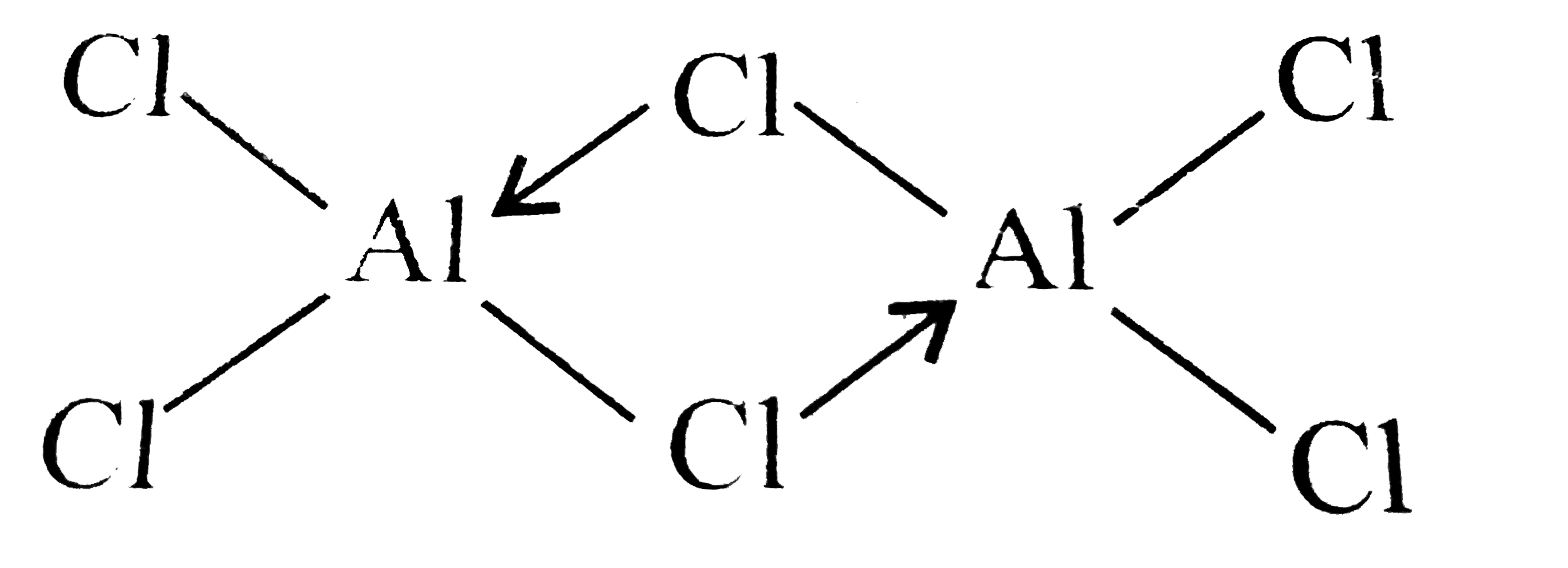Explain the following :
(a) Aluminium vessel can be used to store concHNO3.
(b) AlCl3 forms a dimer, but BCl3 does not.
( c) Al metal is frequency used as a reducing agent for the extraction of metal such as Cr, etc.
(d) Al cannot be prepared by the electrolysis of aqueous solution of its salt.
( e) The B−X distance is shorter than what is expected theoretically in BX3 molecule (X=F,Cl,Br,I).
(f) Althrough the ionisation potential of B(8.30eV) is less than gold (9.22eV), yet B is a non-metal while gold is a metal.
Video Solution
Text Solution
(a) Aluminium metal is rendered passive by nitric acid (HNO3) due to the formation of an oxide layer (Al2O3) on its surface. Hence, Al vessel is not atteacked by concHNO3 and concHNO3 can be easily stored in aluminium vessel.
(b) Both BCl3 and AlCl3 are electron-deficient compounds as both B and Al have only six electrons around them in BCl3 and AlCl3, respectively and hence their octet is incomplete. To complete their octet, pπ−pπ back bonding is not possible in AlCl3 due to increase in size of Al. Hence Al completes its octet by forming dimer in which Cl atom of one AlCl3, donates an electron pair in the vacant 3p orbital of Al by forming a coordinate bond, whereas in BCl3,pπ−pπ back occurs and BCl3 exists as a monomer and not as a dimer.

( c) Aluminium gas great affinity for oxygen. Aluminium thus removes oxygen from the oxides of less electropositive metals and as a good reducing agent.
Cr2O3+2Al→Al2O3+2Cr
(d) Aluminium cannot be prepared by the electrolysis of aqueous solution of its salt, as discharge potential of aluminium is higher than the discharge potential of hydrogen. Thus, the aqueous solution containing Al3+ ions and H⊕ ions, when electrolysed, the H⊕ ions rather than Al3+ ions are discharge at cathode and hydrogen is liberated.
At cathode : 2H⊕+2eӨ→H2↑⏐⏐
( e) Due to pπ−pπ back bonding in BX3, the molecule has double bond character, which results in shortening of B−X bond distance in BX3.

(f) Despite the fact that ionsation potential of boron (8.30eV) is less than gold (9.22eV), boron is a non-metal. This is due to difference is structure in the solid state. In general, metals have large number of atoms as neighbours as compared to non-metal. Gold has 12 atoms as neighbours, whereas boron has 6 or less atoms as neighbours in the solid state.
|
Topper's Solved these Questions
- P-BLOCK GROUP 13 - BORON FAMILYBOOK - CENGAGE CHEMISTRYCHAPTER - P-BLOCK GROUP 13 - BORON FAMILYEXERCISE - Solved Examples
16 Videos
- P-BLOCK GROUP 13 - BORON FAMILYBOOK - CENGAGE CHEMISTRYCHAPTER - P-BLOCK GROUP 13 - BORON FAMILYEXERCISE - Ex 6.1 (Subjective)
17 Videos
- ORGANIC REACTION MECHANISMBOOK - CENGAGE CHEMISTRYCHAPTER - ORGANIC REACTION MECHANISMEXERCISE - Analytical and Descriptive
6 Videos
- P-BLOCK GROUP 14 - CARBON FAMILYBOOK - CENGAGE CHEMISTRYCHAPTER - P-BLOCK GROUP 14 - CARBON FAMILYEXERCISE - Exercises Archives (Subjective)
9 Videos
Similar Questions
Knowledge Check
The metal which cannot be obtained by electrolysis of aqueous solution of its salts is
AAgBZnCCuDAlThe metal that cannot obtained by electrolysis of an aqueous solution of its salts is :
ACrBAgCCaDCuThe metal that cannot be obtained by electrolysis of an aqueous solution of its salt is
AAgBCaCCuDCr
The metals which cannot be obtained by electrolysis of aqueous solution of their salts are
View SolutionThe metals that cannot be obtained by electrolysis of the aqueous solution of their salts are
View SolutionThe metals that cannot be obtained by electrolysis of the aqueous solution of their salts are
View SolutionThe metal that cannot obtained by electrolysis of an aqueous solution of its salts is :
View SolutionWhich of the following pairs of metal cannot be obtained by electrolysis of an aqueous solution of its salt ?
View Solution
